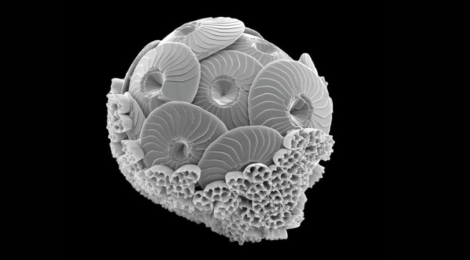
Plankton Threatened By Ocean Acid Trophic Cascade
The word plankton comes from a Greek word πλαγκτός pronounced ‘planktos’ meaning drifters.
Our blue planet is really the plankton planet as they outnumber by a billion times all of life on ‘earth’
Plant plankton, phytoplankton, make 9 out of 10 breaths of oxygen that you inhale, but they are under a terrible threat from our fossil fool age CO2.
An ocean changing trophic cascade due to ocean acidification is outpacing impending climate change as if climate change were standing still
The little drifting ocean plants, like the coccolithophore at the top of this post, many microscopic in size, drift around in the 72% of this blue planet that is our oceans, they number in trillions of trillions. They are, in fact, the custodians of the Earth and its climate. Their numbers have more than halved in the last 50 years, and according to NASA, they continue in this catastrophic decline at a rate of 1% per year. This little known fact ought to be headline news because every living thing on this blue planet depends on them. Trees get all the credit, while its plankton that makes the vast majority of our oxygen
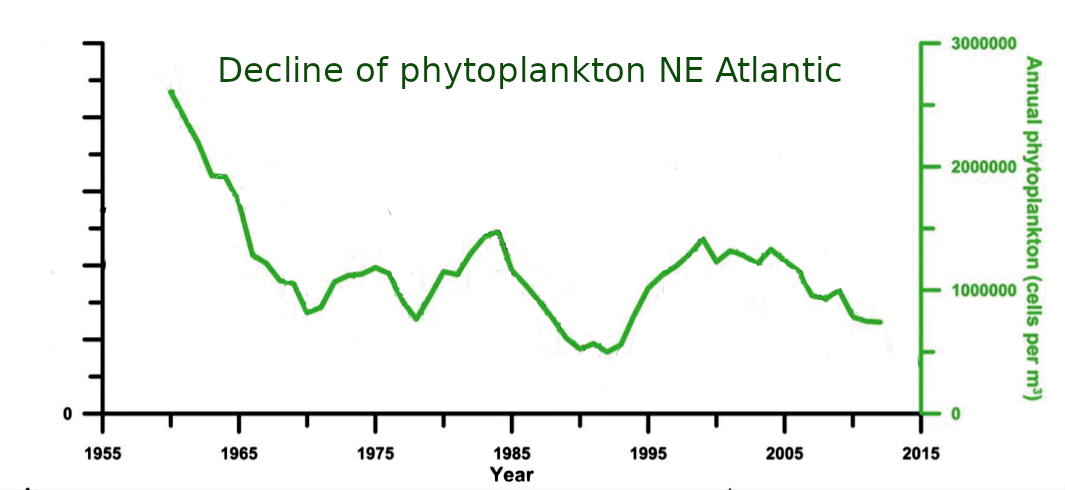
In this chart from a recent scientific paper in a major journal the crisis of lost plankton in the NE Atlantic is seen in the bold blue line. Plankton cells per cubic meter are down from 2.7 million cells per m3 in 1960 to 0.7 million per m3 in 2014, a 74% collapse. Click to enlarge
In making all that oxygen these ocean drifters do so by harvesting sunlight and CO2 to grow. As such they remove vastly more CO2 than all of the plants on land trees and all. All life on earth depends upon plankton for our healthy air and for much of our food, yet we have succeeded in destroying more than 50% of all the plankton in the world’s oceans over the last 50 years.
One of the problems with losing ocean plankton is losing their buffering influence over our CO2. Carbon dioxide dissolves into water and on this blue planet that means into the oceans. When CO2 is added to H2O (water) it will by default become acid H2CO3. That reaction will always take place unless there is a competing process. That is where healthy thriving ocean pasture plankton come in, they are powered by the sun and with their power of photosynthesis, they can easily power their way to convert CO2 for their own use before it becomes acid. That is when they are in their natural health and abundance. That’s not the case today.
Trophic Cascade – Countdown at 25 years and counting.
The pH or acidity of the world’s Oceans has declined from a pH 8.24 during the 1940’s, to pH 8.04 today. Keep in mind that pH numbers change by factors of ten, so we have seen a 2.4% acidity change. The rate of decline is seen to be rapidly accelerating and the IPCC reports this will lead to a pH 7.95 by 2050. As many marine biologists or seawater aquarium keepers will tell you when the pH drops to pH 7.95 then carbonate life forms, calcareous plankton and open ocean mollusks like pteropods start to dissolve and are unable to make their shells. Their disappearance heralds a catastrophic trophic cascade that will destabilize the entire marine ecosystem.
Think of it this way. The acidification of the oceans during the fossil fool age has a capacity to remain healthy so long as the change of pH, acidity, drops to no more than 7.95 pH. In 1960 ocean pH was 8.25. Today we are at 8.05pH. During our yesterday’s of the fossil fool age since 1960, 60 years, we imposed a 0.20 drop to the 8.05pH of today. We have 0.09 pH change left in our ocean life ‘as we like it’ insurance fund, and we are spending our remaining ocean pH safety net fast. At best we have half just 30 years of tomorrow’s left if we do nothing but talk.
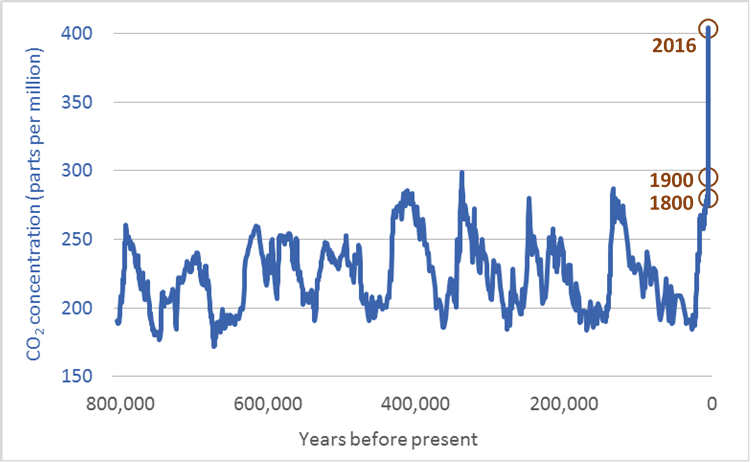
CO2 in Atmosphere 800,000 years to present, clearly not only today’s high and rising levels of CO2 and more so its rate of increase is creating a crisis.
Once the trophic cascade starts it will be very quick, everything will appear almost normal but over a period of perhaps only 3 years, all carbonate-based plankton will be dying. As these species have very short lifetimes, days to months, as they are ‘born’ and tiny they have virtually no ability to resist the acid water, they dissolve before they get a chance to mature. When this major part of the bottom of the ocean food chain disappears they will take most of ocean life as we know it with them. The whales, seal, seabirds, and fish will die as well and along with them, the food supply for 2 billion people. The seas will shift their biology to far less human-friendly cyanobacteria, jellyfish, and the age of oceans of bacterial slime will return.
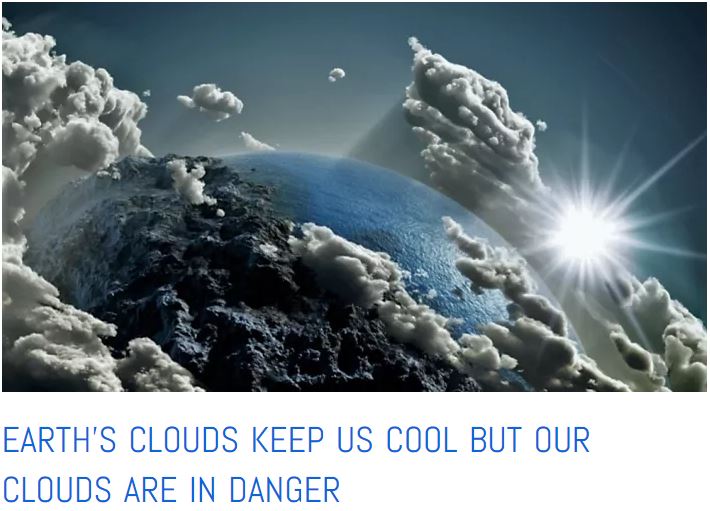
Ocean pasture plankton blooms make the vast majority of clouds that shade our planet and keep it in the ‘Goldilock’s Zone’ Click to read more
Atmospheric oxygen levels are already seen to be dropping more than 4 times quicker than carbon dioxide is increasing. This is entirely due to the slow down of ocean photosynthesis. As we continue to lose the plankton then their ability to buffer ocean acidifying CO2 and perform myriad other climate system services will lead to a dramatic acceleration of climate change.
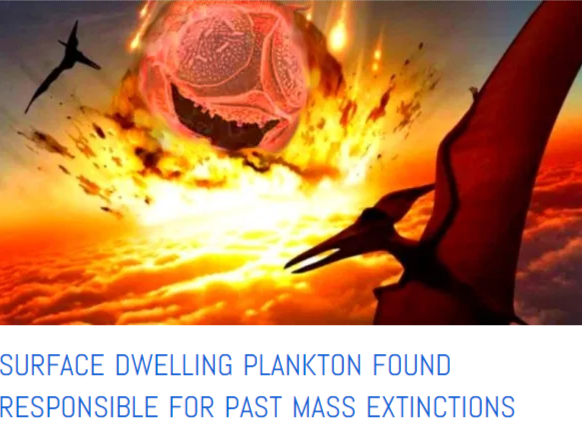
Rapid changes in ocean plankton have been shown to create the most devastating mass extinctions. Click to read more
Ocean life is currently being destroyed 1000 times faster than the great extinction events took place such as when a giant asteroid crashed into the Gulf of Mexico. Indeed when it comes to plankton vs. asteroid impacts with the power to change this planet it is the plankton that put the flaming asteroids to shame.
Somehow humanity has never cared for the oceans as it has for the land and most of us seem to be completely oblivious to what is happening there. We look out from shore and those blue waters don’t seem to have changed. For those who do acknowledge ocean change we just wag our fingers of blame at the usual suspects, it must be those bad fishermen, those bad oil men, those bad navy men, anyone but each of us. We are the real culprits with our individual impacts, multiplied by the 7.5 billion of us, along with our determined refusal to think of the ocean the way we think of our beloved land.
How and why is this happening
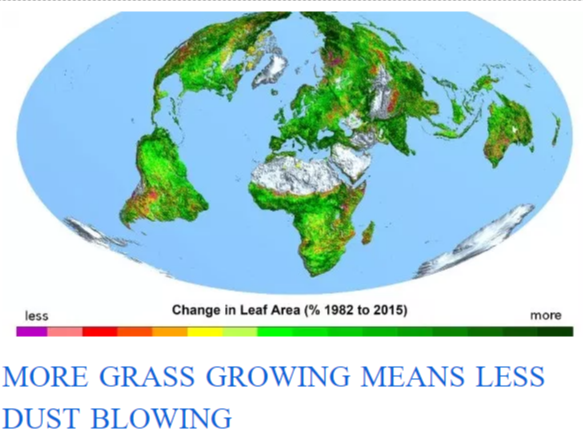
A multi-national team has just published a study titled “Greening of the Earth and its Drivers“ in the journal Nature Climate Change showing significant global greening of Earth’s vegetated lands using data from NASA satellites over the past 33 years. Click to read more.
More grass growing means less dust blowing. It is as simple as that. Dustfall is what keeps ocean pastures green and growing, its just the converse of rainfall being needed to keep pastures of grass on land green and healthy. In this the 100th year of our fossil fool age the trillion tonnes of CO2 has been feeding plants on land, and don’t forget this planet is mostly covered with grass as opposed to trees.
Today’s high and rising CO2 fed grass covers the land and that means when the wind blows the dust doesn’t. So once again, more grass growing means less dust blowing and that is driving the collapse of ocean plankton as it is dying from decades of dustfall drought.
The ocean pasture ecosystems can be saved and recover in short order if we act in time. Plankton productivity will bounce back and once again manage most of the planet’s CO2. Indeed plankton productivity is 1000 times that of trees, so once we take action to replenish and restore the blue part of this blue planet Mother Nature’s most abundant of all life, the plankton will do the rest. The 50% loss of plankton productivity once restored to the natural condition of health and abundance it was at just 50 years ago will see not less than 25 billion tonnes of carbon dioxide repurposed as new ocean life.
A simple proven prescription to save this blue planet
Here’s my proven, simple, sustainable, safe, affordable, and immediately deployable solution that the human race must move forward with to save our oceans (and ourselves) from the global greening and grass growing ravaging of this blue planet. IT JUST WORKS!
We must replenish the dust our modern age has and is denying the oceans and their vital pastures. By giving back tiny amounts of mineral-rich dust to the oceans we can bring back all of ocean life, the plankton, the krill, the squid, the seabirds, the seals and sea lions, the great whales, and the fish!
The cost of restoring our ocean pastures to historic levels of health and abundance will be absolutely trivial when compared to the expected trillions to be spent annually to full-fill the terms of the recent Paris Climate Change Accord. My proven methodology and technology can, and will, safely and sustainably restore ocean pastures in all of the world’s seven seas for mere millions of dollars, NOT trillions!
My 2012 ocean pasture dust replenishment and restoration work in the NE Pacific returned the ocean to life as seen in the largest catch of salmon in all of history in Alaska the next year. Click to read more!











In a slightly less imperfect world economy Australia could pay for its carbon sins with iron
fertilization of the Southern oceans
Presently Australia it is the world’s biggest coal exporter
and third biggest fossil fuel exporter behind SA and Russia.
However it is also the biggest iron exporter with huge infrastructure in West Australia for mining of iron ore and export to China..
Last time the drought and winds dropped megatonnes of Australian red dust into the ocean… it responded with prolific plankton..
http://theconversation.com/how-australias-biggest-dust-storm-went-on-to-green-the-ocean-47695